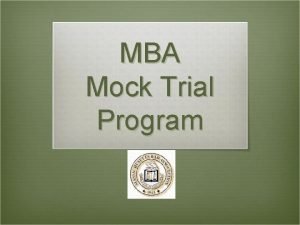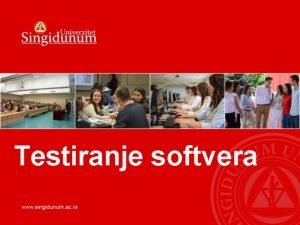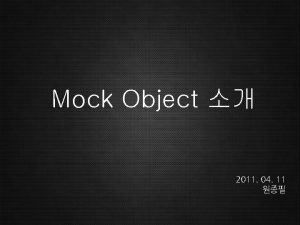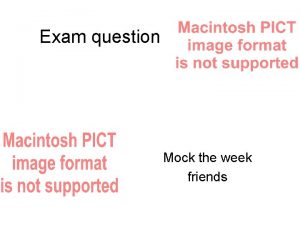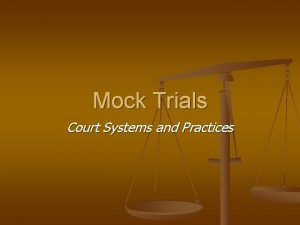Mock Conference An Introduction 2 Our first mock
















- Slides: 16

Mock Conference An Introduction

2 Our first “mock” conference is next week! First, there will be a topic.

Topic The “World Music Organization” wants to minimize the negative influences of certain genres of music on children by increasing restrictions on types of music that are too mature for younger audiences. You have been assigned to represent a particular genre of music. How do you want to proceed?

4 Who is in charge of a conference?

The Dais • Chair – Oversees all aspects of the conference • Director – Guides delegates through the Resolutions/Amendments process • Rapporteur – Calls roll, keeps time, counts votes • Staff – Keeps notes, works on the computer • Helper – Passes notes for delegates

6 How can I ask a question at the conference?

Points • Point of Order (I think a mistake was made. ) ▫ Used to tell the Chair that he/she has made an error in the running of the committee. • Point of Inquiry (I have a question about…) ▫ Used to ask the Chair a question about the rules of procedure. • Point of Personal Privilege (I need to use the bathroom, etc…) ▫ Used to tell the Chair about a specific problem of the delegate (i. e. can’t hear, room is too hot, etc. ) • Point of Information (You have a question for another delegation) ▫ Used to ask a speaker a question during formal debate.

1. Roll Call • Attendance! • Stand up and say, “Delegation from ____ is present. ”

2. Speaker’s List • AKA “Formal Debate” • When delegates give their OPENING SPEECH • SPEAKING TIME is 1 min 30 secs ▫ A country may only be on the Speakers’ List once………… • BUT delegates may add their country to the end of the list again after they give their opening speech. (Send a note)

2. Speaker’s List (cont’d) • Country that motions to open the Speaker’s List goes first; after that, goes in order of the list. • “Honorable Chair, (country name) moves to open the Speakers’ List with a speaking time of 90 seconds. ” • How to add yourself to the Speakers List? ▫ Raising your placard at the beginning of debate. ▫ Passing a note to the Staff member stating your request.

…Yield… What if you don’t speak for the whole 90 seconds? ? • YIELD your time. ▫ “To the Chair” (ends your time) ▫ To another delegate (this allows another delegate with similar views to speak) ▫ To Points of Information (so other delegates can ask you questions)

3 A. Moderated Caucus • Informal debate • Motion for a MC if you hear something in an opening speech that you want to debate or discuss more freely. • SPEAKING TIME vs TOTAL TIME ▫ “(Country) motions to move into a Moderated Caucus with a total time of 10 minutes & a speaking time of 45 seconds. ” • Motions can fail. • When time is up for the MC, go back to Speaker’s List

3 B. Unmoderated Caucus • Most informal type of debate. Delegates can move freely about the room and discuss ideas openly with each other. • Total Time ONLY (no speaking time limit) ▫ “(Country) motions to move into an Unmoderated Caucus with a total time of ___ minutes. ” • Form alliances! • Also possible to extend Unmoderated Caucus Time during debate with a Motion.

4. Resolution • The final result of discussion and negotiation throughout the conference. • SPONSORS vs SIGNATORIES ▫ Sponsors: The principal authors of a resolution. ▫ Signatories: Delegations that wish to see the resolution debated in the committee. • At least 20% of the committee must be a sponsor or a signatory of a draft resolution in order for it to be brought to a vote. • Must contain (in writing) what the problem the country is trying to address, why they are trying to address it, and how they plan to address it.

5. Amendments • Written statement(s) that add, delete, or revise an Operative Clause in a Draft Resolution

6. Voting on resolutions • Led by Rapporteur ▫ Can vote FOR, AGAINST, or ABSTAIN • A 50% vote is needed for a Resolution to pass. • It’s OK if all, one, or none of the Resolutions pass!
 Thinking affects our language, which then affects our:
Thinking affects our language, which then affects our: Our census our future
Our census our future Longing for peace our world is troubled
Longing for peace our world is troubled Marcus aurelius our life is what our thoughts make it
Marcus aurelius our life is what our thoughts make it We bow our hearts we bend our knees
We bow our hearts we bend our knees Our census our future
Our census our future Our life is what our thoughts make it
Our life is what our thoughts make it We quail money makes us quail
We quail money makes us quail Awareness of ourselves and our environment is
Awareness of ourselves and our environment is Awareness of ourselves and our environment is:
Awareness of ourselves and our environment is: God our father christ our brother
God our father christ our brother Our future is in our hands quotes
Our future is in our hands quotes Our awareness of ourselves and our environment.
Our awareness of ourselves and our environment. Our awareness of ourselves and our environment
Our awareness of ourselves and our environment Housing first partners conference
Housing first partners conference First educational conference 1947
First educational conference 1947 Welcome to our first meeting
Welcome to our first meeting






















